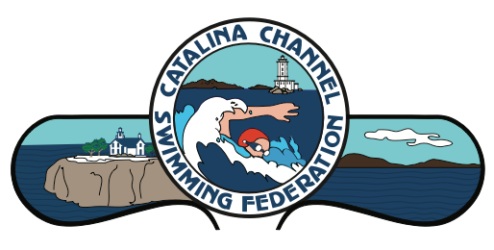Kayak Classes in La Jolla & Alamitos Bay
David Clark Instructs Techniques for Navigation & Safety
As one veteran Catalina crosser puts it: “If you’re not training with your
paddler, then you’re not yet training for Catalina.” Luckily, David Clark has dedicated two weekends for swimmers and their kayak support to learn the skills crucial for a successful Catalina Channel swim. His free classes cover navigation, feeding, and safety support of open water swimmers. A good portion of the session is spent in the water so swimmers & their paddlers can practice their teamwork.
The first session is THIS Saturday June 11th at La Jolla Shores. Details are available at the La Jolla Cove Swim Club website. The second session will be Saturday July 9th in Alamitos Bay, which is between Seal Beach and Long Beach.
RSVP to David Clark at 858.453.0648
Jim Neitz’s Successful Crossing in May
200th Catalina Swimmer & Earliest Swim in Over 50 years
Jim Neitz celebrates on the mainland Congratulations to Ventura County swimmer Jim Neitz on an impressive early-season crossing. The “rocky waters” in the night hours of May 26th created some discomfort for his support team, but he soldiered on becoming the 200th person to swim the Catalina Channel. Final time: 12 hours and 14 minutes.
Please note: Planning is already underway for the annual CCSF awards banquet, where we honor all the swimmers and celebrate each successful crossing. Traditionally, the ceremony falls on the first weekend of November. At that time, the CCSF list of Successful Solo crossings will be updated with 2011 swims. Until then, final times published in the newsletter are considered unofficial (but we hope accurate).
Catalina Challenge: Swimming at Night
Nighttime Brings Fears, Vertigo, But Also a Peacefulness
One of the challenges of the Catalina Channel is the 24-hour weather pattern in Southern California. On your typical summer day, the early morning seas are relatively calm but the afternoon becomes windy – on occasion, too difficult for a marathon swim. So most Catalina attempts start in the dead of night. Therefore, any Catalina swimmer needs to prepare for about 6 hours of nighttime swimming. Most of your open water friends would balk at 6 hours of non-stop swimming, much less in complete darkness. Catalina swimmers are different.
It takes practice to get comfortable in the darkness. In addition, navigation is much more difficult. A swimmer’s depth perception is thrown off. At midnight, near Catalina Island, it gets so dark that the horizon disappears. The sea and sky are the same inky blackness. Swimmers and supporters alike have complained of nausea– a combination of seasickness and impaired equilibrioception.
Swimmer’s Night Illumination: Glowsticks
CCSF Swimmers Expected to Supply Safety Light Sticks
Beyond the preparation of nighttime, swimmers are expected to supply their crew with safety “glow sticks”. Last summer, Steven Munatones compiled an excellent review of possible illumination gear. Munatones asked swimmers and organizers around-the-world for their advice on safe nighttime swimming.
The saying goes: If it’s vital to the swim, you’d better attach a glowstick to it. Otherwise, in the middle of the night, there’s no locating items lost in the water. That goes for kayaks, paddles, kayakers, companion swimmers, and feeding gear. All can be outfitted with safety lights. It’s practically impossible for a Catalina swimmer to arrive at the escort boat carrying too many glowsticks. Which is the best color? The US Military approves of the green chem light. They’re available at any marine supply store, hardware and camping retailers, or online.
A word of caution: Party supply stores have inexpensive glowsticks, bracelets and chem light trinkets. They seem beautiful at backyard barbecues and concerts, but are essentially worthless where safety is concerned. Spend a little extra money to get 6-inch chemical glow sticks which burn bright for at least 12 hours… The success (and safety) of your swim may depend on it.
Flashback: Record-Distance Ocean Swim
Paul Chotteau Completes Channel Swim to Santa Monica
Perhaps the most persistent Catalina swimmer was Paul Chotteau. He tried 5 times before he finally made a remarkable long-distance swim from Catalina Island to Santa Monica. The crossing took over 33 hours. Because Chotteau didn’t wear goggles, the salt water blinded him. He needed assistance from lifeguards to get past the breaking surf and safely to shore. His 38-mile journey, the longest recorded ocean swim at the time, was 75 years ago. How did he manage these swims during the heart of the Great Depression? Chotteau Paul had a knack for garnering press attention. Based on written accounts, he had the sportswriters believing he was a classical violinist in the Paris Conservatory, a World War 1 flyer, an English Channel swimmer, and the inventor of a “shark-powered water buggy”. Only Chotteau knew what was fiction or fact. For sure, he never needed to embellish his open water feats.
Two years later, in 1938, Chotteau made another daring attempt in Southern California. This time from Santa Barbara Island (shortest distance: 40 miles to the California coast) He fell short of his goal, but this time around wore goggles — and apparently not a swim cap

Leave a Reply